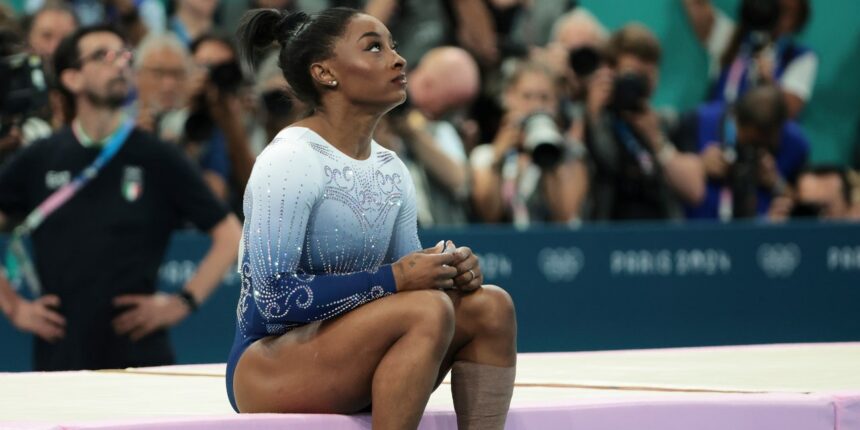If you eagerly followed the US women’s gymnastics team at the Paris Olympic Games last summer, you probably remember seeing Simone Biles’s calf wrapped in athletic tape as she limped, and at one point even crawled, across the competition floor. At the time, she didn’t divulge the specifics of her condition, nor did she let it prevent her from winning four medals. But in part two of her Netflix documentary, Simone Biles Rising, released today, the 27-year-old phenom details the severity of her injury—and illuminates how much worse it could have been.
On day one of the women’s gymnastics qualifications in Paris, a nervous Biles took the floor to warm up. She and her teammates were given limited time, she recalled in episode three of the docuseries, and to be efficient, she wanted to “do the least amount.” So she decided to do her iconic triple-double, also known as the Biles II, and as soon as she took off toward the vault, something in her lower leg went shhhht, as she put it.
“I was like, ‘Ooh, oh. That hurt really bad. That didn’t feel right. I just felt, like, a weird sensation in my calf muscle,” Biles told the cameras. As she hovered and twisted in the air, she feared that she had torn her Achilles tendon—the band of tissue that links your calf muscles to your heel bone. After all, just a few months prior at the 2024 Olympics Trials, she witnessed three leg injuries—two of which were Achilles-related—take her teammates Kayla DiCello, Skye Blakely, and Shilese Jones out of the running. Deep down, she always feared she was next. “Whenever something like that happens, you’re so terrified,” Biles said. “An injury can happen to any of us at any point.”
An Achilles tear is a sometimes career-ending injury that’s common among gymnasts. In fact, a 2021 study published in Sports Health found the risk of Achilles injuries to be 10 times higher in collegiate women’s gymnastics than in any other college sport. Research also suggests that the momentum-building run that launches gymnasts into floor exercises like vault and tumbling is most often the culprit of Achilles blows—and that’s exactly what Biles was doing when she felt her lower leg rip.
After hobbling off the mat in Paris, Biles and her team of coaches and medical experts were forced to make a big decision with little time to spare: Would she continue competing, or would she withdraw from the Games (and face backlash) as she did at the 2020 Tokyo Olympics after battling the “twisties”? Biles considered it an unwelcome “déjà vu” moment. “Ugh. It was so annoying. And I think that’s what irritated me the most,” she recalled. “As soon as I got off the floor, I was like, ‘People are gonna think I’m quitting again.’”
And she wasn’t willing to let that happen. So she pressed on and, for her remaining time in Paris, straddled the line between preparedness and overdoing it. Coaches monitored her stretching, she wore a compression sleeve on her calf, and Team USA Gymnastics’ physician Marcy Faustin, MD, helped manage her pain—which, thankfully, didn’t get worse throughout the rest of the Games. Her coach, Laurent Landi, ultimately told cameras that Biles was diagnosed with a calf “strain slash tear.”
Read the full article here



